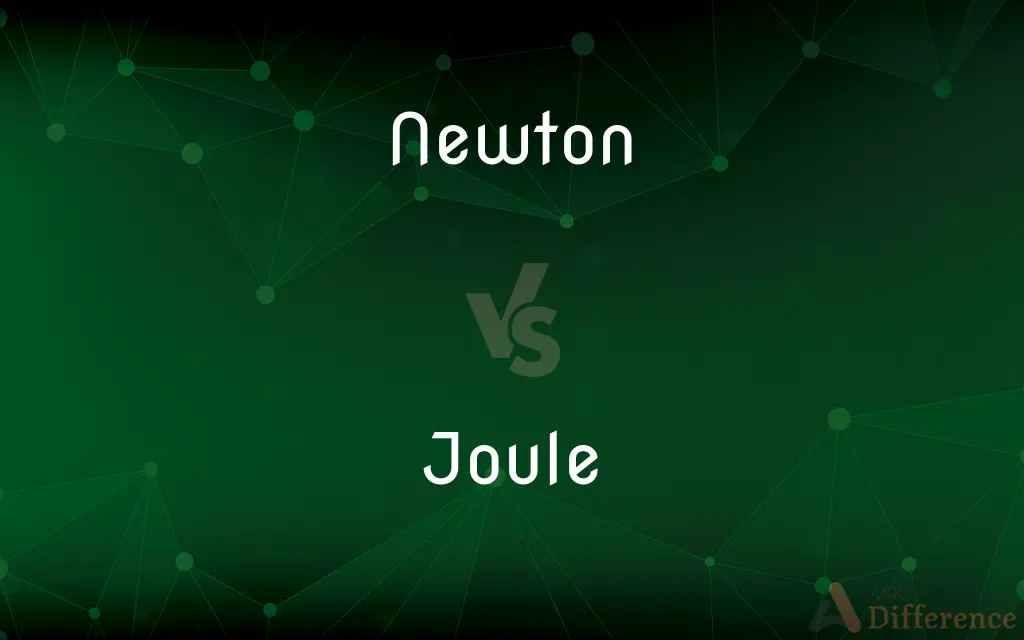Newton vs. Joule — What's the Difference?
Edited by Tayyaba Rehman — By Urooj Arif — Updated on March 26, 2024
A Newton measures force, while a Joule measures energy or work done.

Difference Between Newton and Joule
Table of Contents
ADVERTISEMENT
Key Differences
Newton (N) is the International System of Units (SI) unit of force. It is defined as the force necessary to accelerate a mass of one kilogram at a rate of one meter per second squared. The concept of force is fundamental in physics, describing the interaction that changes the motion of objects. On the other hand, Joule (J) is the SI unit of energy, work, or amount of heat. One Joule is the amount of work done when a force of one Newton is applied over a distance of one meter in the direction of the force. This unit is central to understanding energy transfer, consumption, and conservation in various fields, including physics, engineering, and environmental science.
While the Newton focuses on the aspect of force applied in physics, indicating the interaction between objects that results in motion or attempts to create motion, the Joule deals with the concept of energy transfer or work done as a result of that force. For example, pushing a box across the floor involves a certain force (Newtons) and doing work on the box, which is quantified in Joules, based on how far it's pushed and the force applied.
In practical applications, Newtons are used to quantify forces in engineering, mechanics, and physical sciences, such as the force required to lift an object, the force of gravity on an object, or the force produced by engines. Joules, whereas, are used to measure the energy consumed by appliances, the work done by machines, or the kinetic energy of moving objects. Understanding both units is essential for solving problems and designing systems in physics and engineering.
The relationship between Newtons and Joules is intertwined with the fundamental physics equations, such as work done (Work = Force x Distance) and kinetic energy (Kinetic Energy = 1/2 mv^2, where m is mass and v is velocity). This relationship highlights how forces cause objects to move and how this movement or resistance to movement translates into energy or work done, showcasing the practical significance of both units in describing physical phenomena.
While Newtons are purely concerned with the quantitative measure of force, Joules encompass a broader spectrum of physical phenomena, including potential and kinetic energy, heat, and work. This distinction underscores the versatility of Joules in expressing various forms of energy and their transformations, in contrast to the more specialized application of Newtons in describing forces.
ADVERTISEMENT
Comparison Chart
Definition
Unit of force
Unit of energy, work, or heat
Application
Measures the force applied to objects
Measures the energy transferred or work done
Equation
F = ma (force = mass x acceleration)
W = Fd (work = force x distance)
Context
Used in mechanics, physics
Used in physics, energy studies, engineering
Fundamental Concept
Force
Energy transfer or work
Compare with Definitions
Newton
Widely used in engineering and science.
Engineers calculate forces in structures using Newtons.
Joule
SI unit of energy, work, or heat.
Lifting a book 1 meter high against gravity does work of about 1 Joule.
Newton
Quantifies interaction that changes motion.
The gravitational force on an apple is measured in Newtons.
Joule
Central to physics, engineering.
The work done by an electric heater is calculated in Joules.
Newton
SI unit of force.
Applying a force of 10 N accelerates a 1 kg mass at 10 m/s².
Joule
Used to express different forms of energy.
The amount of heat required to raise water's temperature is in Joules.
Newton
Indicates action that results in motion.
The tension in a rope during tug of war is expressed in Newtons.
Joule
Measures how energy is moved or transformed.
The energy consumed by a light bulb is measured in Joules.
Newton
Essential for understanding mechanics.
Calculating the force required to move an object involves Newtons.
Joule
Encompasses kinetic and potential energy, heat.
The kinetic energy of a moving car is quantified in Joules.
Newton
The SI-derived unit of force required to accelerate a mass of one kilogram one meter per second per second, equal to 100,000 dynes. See Table at measurement.
Joule
The joule ( jowl, jool; symbol: J) is a derived unit of energy in the International System of Units. It is equal to the energy transferred to (or work done on) an object when a force of one newton acts on that object in the direction of the force's motion through a distance of one metre (1 newton-metre or N⋅m).
Newton
In the International System of Units, the derived unit of force; the force required to accelerate a mass of one kilogram by one metre per second per second. Symbol: N.
Joule
The International System unit of electrical, mechanical, and thermal energy, equal to the work done when a force of one newton acts through a distance of one meter, and also equal to the work done when a current of one ampere is passed through a resistance of one ohm for one second.
Newton
English mathematician and physicist; remembered for developing the calculus and for his law of gravitation and his three laws of motion (1642-1727)
Joule
In the International System of Units, the derived unit of energy, work and heat; the work required to exert a force of one newton for a distance of one metre. Equivalent to one watt of power for a duration of one second. Symbol: J
Newton
A unit of force equal to the force that imparts an acceleration of 1 m/sec/sec to a mass of 1 kilogram; equal to 100,000 dynes
Joule
A unit of work which is equal to 107 ergs (the unit of work in the C. G. S. system of units), and is equivalent to one watt-second, the energy expended in one second by an electric current of one ampere in a resistance of one ohm; also called the absolute joule. It is abbreviated J or j. The international joule is slightly larger, being 1.000167 times the absolute joule. The absolute joule is approximately equal to 0.737562 foot pounds, 0.239006 gram-calories (small calories), and 3.72506 x 10-7 horsepower-hours, and 0.000948451 B.t.u.
Joule
A unit of electrical energy equal to the work done when a current of one ampere passes through a resistance of one ohm for one second
Joule
English physicist who established the mechanical theory of heat and discovered the first law of thermodynamics (1818-1889)
Common Curiosities
How is a Joule defined?
A Joule is defined as the work done or energy transferred when a force of one Newton is applied over a distance of one meter.
Can Newtons be converted to Joules directly?
Direct conversion isn't applicable because they measure different things: force versus energy. However, their relationship is fundamental in equations for work and energy.
What does a Newton measure in physics?
It measures force, the interaction that causes or attempts to cause motion.
How do Newtons relate to motion?
Newtons describe the amount of force causing an object to move or accelerate.
What demonstrates the practical use of Newtons in engineering?
Designing structures to withstand specific forces or calculating engine thrust.
Why are Joules important in energy studies?
Joules quantify energy transfer, crucial for understanding consumption, efficiency, and conservation in various applications.
What's an example of Newton's application in everyday life?
Calculating the force needed to lift objects or the force of gravity acting on them.
What's an example of using Joules in real-life situations?
Measuring the electrical energy used by household appliances over time.
Is kinetic energy measured in Newtons or Joules?
Kinetic energy is measured in Joules, as it relates to the energy of motion.
Can the concept of force be applied to non-physical interactions?
In physics, force is a physical concept, but metaphorically, it can describe influences in non-physical contexts.
How do the concepts of Newtons and Joules intersect in mechanical work?
In mechanical work, the force applied over a distance (Newtons acting over meters) results in energy transfer or work done, measured in Joules.
In what way are Joules used in engineering?
They are used to calculate the work done by machines or the energy stored in systems.
Why might an engineer need to understand both Newtons and Joules?
Understanding both units is crucial for solving problems related to forces and energy in the design and analysis of machines, structures, and systems.
What unit would be used to describe the energy output of a battery?
The energy output of a battery would be described in Joules.
How does understanding Joules benefit environmental science?
It aids in assessing energy sources and their impacts on ecosystems.
Share Your Discovery

Previous Comparison
Liberty vs. Equality
Next Comparison
Also vs. TooAuthor Spotlight
Written by
Urooj ArifUrooj is a skilled content writer at Ask Difference, known for her exceptional ability to simplify complex topics into engaging and informative content. With a passion for research and a flair for clear, concise writing, she consistently delivers articles that resonate with our diverse audience.
Edited by
Tayyaba RehmanTayyaba Rehman is a distinguished writer, currently serving as a primary contributor to askdifference.com. As a researcher in semantics and etymology, Tayyaba's passion for the complexity of languages and their distinctions has found a perfect home on the platform. Tayyaba delves into the intricacies of language, distinguishing between commonly confused words and phrases, thereby providing clarity for readers worldwide.














































